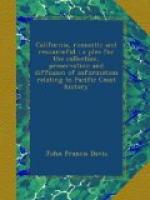V.
Forty years on wall and bastion swept the hollow idle
breeze,
Since the Russian eagle fluttered from the California
seas;
Forty years on wall and bastion wrought its slow but
sure decay,
And St. George’s cross was lifted in the port
of Monterey;
And the citadel was lighted, and the hall was gayly
drest,
All to honor Sir George Simpson, famous traveler and
guest[16].
Far and near the people gathered to the costly banquet
set,
And exchanged congratulations with the English baronet;
Till, the formal speeches ended, and amidst the laugh
and wine,
Some one spoke of Concha’s lover, — heedless
of the warning sign.
Quickly then cried Sir George Simpson: “Speak no ill of him, I pray! He is dead. He died, poor fellow, forty years ago this day,
“Died while speeding home to Russia, falling from a fractious horse. Left a sweetheart, too, they tell me. Married, I suppose, of course!
“Lives she yet?” A deathlike silence fell on banquet, guests, and hall, And a trembling figure rising fixed the awestruck gaze of all.
Two black eyes in darkened orbits gleamed beneath the nun’s white hood[17]; Black serge hid the wasted figure, bowed and stricken where it stood.
“Lives she yet?” Sir George repeated. All were hushed as Concha drew Closer yet her nun’s attire. “Senor, pardon, she died, too!”
[1] Pronounced Hoo-neep-ero, with the accent on the second syllable.
[2] The best pen-picture of San Francisco just before the discovery of gold that I know of is that given by one who was an eye-witness: “At that time (July, 1847), what is now called San Francisco was called Yerba Buena. A naval officer, Lieutenant Washington A. Bartlett, its first Alcalde, had caused it to be surveyed and laid out into blocks and lots, which were being sold at sixteen dollars a lot of fifty varas square; the understanding being that no single person could purchase of the Alcalde more than one in-lot of fifty varas, and one out-lot of a hundred varas. Folsom, however, got his clerks, orderlies, etc., to buy lots, and they, for a small consideration, conveyed them to him, so that he was nominally the owner of a good many lots. Lieutenant Halleck had bought one of each kind, and so had Warner. Many naval officers had also invested, and Captain Folsom advised me to buy some, but I felt actually insulted that he should think me such a fool as to pay money for property in such a horrid place as Yerba Buena, especially in his quarter of the city, then called Happy Valley. At that day Montgomery Street was, as now, the business street, extending from Jackson to Sacramento, the water of the bay leaving barely room for a few houses on its east side, and the public warehouses were on a sandy beach about where the Bank of California now stands, viz., near the intersection of Sansome and California streets . . . . . . . The population was estimated at about four hundred, of whom Kanakas (natives of the Sandwich Islands) formed the bulk.” — Personal Memoirs of General W. T. Sherman (Charles L. Webster & Co., New York, 1891), p. 61.




